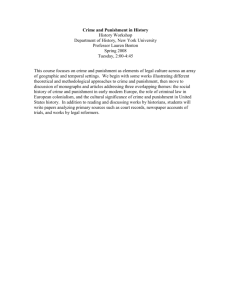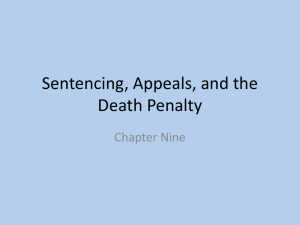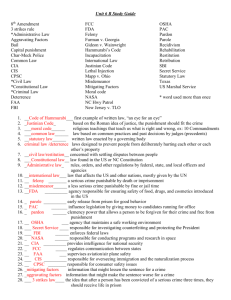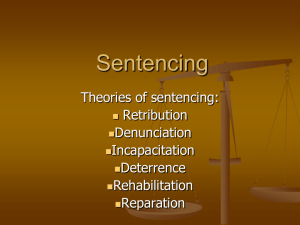Chapter 15 Sentencing Options
advertisement
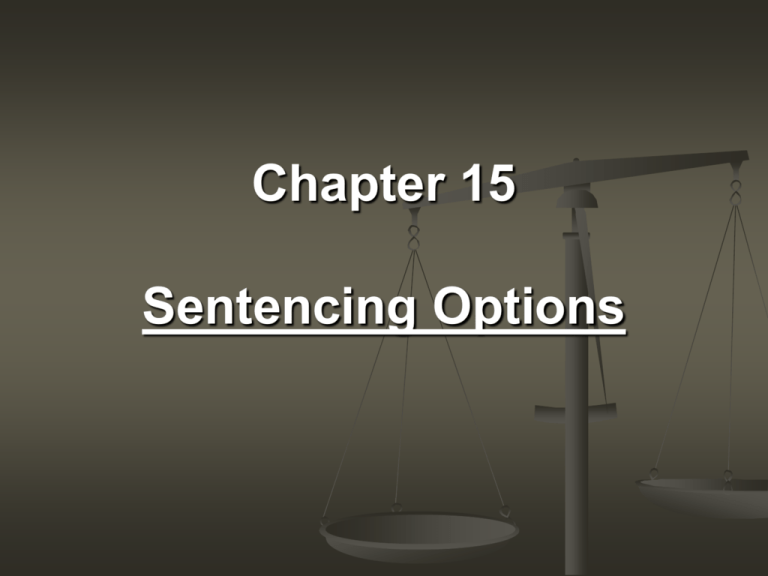
Chapter 15 Sentencing Options Questions Why do we sentence? Should the punishment fit the crime? or, Should the punishment fit the criminal? Philosophies of Punishment Retribution l Incapacitation l Deterrence l Rehabilitation l Restorative Justice Questions: Should we direct punishment toward the future deterrence of crime? Or, Should we direct punishment toward the past behavior of criminals to compensate for the severity of the crime and the suffering of the victim? Retribution “Lex Talionus” An eye for an eye, a tooth for a tooth. Revenge Just Desserts The severity of the punishment should be proportionate to the gravity of the defendant’s conduct. Retribution emphasizes the individual’s past behavior with no concern for future criminality and, it is contrary to the goal of crime reduction. In other words, the goal is to punish past crimes. Incapacitation Physical Restraint Incapacitation focuses on personal characteristics of the offender – the type of person committing the crime is more important than the crime. The goal is to prevent future crimes not punish past ones. Selective Incapacitation The policy of creating enhanced prison sentences for the relatively small group of dangerous chronic offenders. Focuses on the offender and future crime. Deterrence Deterrence rests on the assumption of rational, calculating behavior. General Deterrence seeks to prevent the general populace from committing future crimes. It is not content to punish the individual offender. Specific Deterrence seeks to prevent the individual offender from committing future crimes – not change them, just deter them. Focuses on the offender. Rehabilitation Treatment Rehabilitation assumes that criminal behavior is a result of social or psychological disorders and that treatment is the primary goal. Offenders are not necessarily punished but treated for their own good and the good of society. Focuses on the offender. Restorative Justice Social Harmony The potential for restoring social relations damaged by crime is to be found not in the state (legalistic view), but in social groups, i.e., families and communities. Therefore, Restorative Justice addresses crime as a conflict between the victim – offender – community. The primary goal is to repair and reconcile injuries; punishment is secondary. Social integration of the offender is paramount. Questions: What are some problems with each of the philosophies of punishment? Who has the initial responsibility for creating sentencing options? What are two sentencing options for imprisonment? Of the three branches of government, what role does the judiciary and executive branch play in sentencing? Judicial Sentencing Responsibility Only judges have the authority to choose among the sentencing options provided by the legislature. Executive Sentencing Responsibility Length of sentences are determined partly by officials of the executive branch: governors, parole boards, and departments of corrections. The three most common types of ‘early’ release are: Parole is the conditional release of an inmate from incarceration, under supervision, after a portion of their time has been served. Good time incorporates days off inmates’ minimum or maximum terms as a reward for good behavior or for participation in various vocational, educational, and treatment programs. Executive clemency or Pardons are authorized by the president of the U.S. and state governors. This includes reducing the sentence, making the prisoner eligible for parole, or, a full pardon. Prisons and Imprisonment Questions: What is a reason for the high rate of imprisonment (incarceration) in the Unites States? How do our skyrocketing prison populations compare to crime rates during the last decade? Do you think the “get tough on crime” policy advocated by legislators is a means in which to increase the prison construction business? What is the approximate cost to “house” a prisoner for one year? Probation Punishment for a crime that allows the offender to remain in the community without incarceration (but under supervision) and subject to certain conditions. Conditions of probation are prescribed by the sentencing judge, i.e., maintaining a job, reporting in, and supporting a family. The judge can revoke probation and send the offender to prison if the conditions of probation are violated. Probation is the most common sanction used in the United States (approximately 4 million adults). Intermediate Sanctions Alternative sentences that lie somewhere between prison and probation which can include community based penalties such as: fines, community service, restitution, intensive probation, electronic monitoring, house arrest, shock incarceration, boot camp, and treatment. Questions: Fines are one of the oldest and most widely used forms of punishment – do you think ‘day fines’ or ‘structured fines’ would be appropriate punishment for ‘jail’ offenses? What is restitution? What is the difference between ‘direct’ restitution and ‘symbolic’ restitution? Death Penalty Capital Punishment – Capital Offense (8th Amendment – ‘Cruel and Unusual Punishment’) Furman v. Georgia (1972) (Invalidated Death Penalty) Gregg v. Georgia (1976) (Death Penalty is valid with Guided Discretion) Coker v. Georgia (1977) (Rape is not grave enough for the Death Penalty) All jurisdictions but Arkansas allow automatic review after a sentence of death is imposed. Discussion Questions: Which issue might offer the best argument for abolishing the death penalty – morality, deterrence, or fairness? What are the age limits in which the Supreme Court allows or disallows the death penalty? What mental conditions disallow the death penalty? How are jurors affected during peremptory challenges in death penalty cases?


